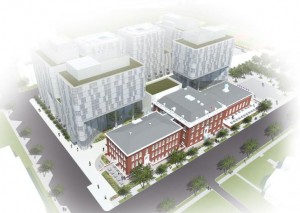
Last month Southwest community leaders came to an agreement with Telesis, the developers of the Randall School. For those not familiar with the development plan, over half of the existing structure will be demolished and a much larger, 130-foot building will rise in its place. The new complex will include an art museum, bookstore, café, auditorium and 550 new residences.
While there are a number of things to cheer about, this development will intensify the demand for finite resources, such as park land, recreation facilities, schools, and transportation infrastructure. Community leaders expressed concerns about direct impacts on the adjacent Randall Recreation Center, including the residential tower shadowing the swimming pool, and a vehicular drop-off circle carved out of what’s long been considered part of the recreation center.
Traditionally, maintenance and enhancements to public resources were provided through the government’s operating and capital budgets. Recently, however, DC has been reducing its direct expenditures. For example, the DC Department of Parks and Recreation used to assign 3 full time staffers to Randall Recreation Center, keeping it open six hours a day except on Sundays. Now, not only has DC eliminated the staff, it’s also inadequately maintaining the facility.
Southwest community leaders have been striving to fill in the gap. One crucial tool is a zoning procedure known as the Planned Unit Development process. Developers wishing to build more than what’s allowed at the base zoning level must go through this public process wherein the marginal impacts of the development must be offset by a corollary set of benefits. The decision is made by the zoning commission based on an analysis by the Office of Planning and testimony from stakeholders.
We applaud Telesis for agreeing to a commendable package of benefits, including affordable housing, new open space, and transportation improvements. Among other artistic benefits, Telesis agreed to free admission to the museum for ANC 6D residents, supporting a visual arts project, organizing an exhibit of ANC 6D resident artwork, as well as organizing & sponsoring a free annual art festival. Community leaders are particularly grateful that Telesis agreed to contribute $20,000 toward a comprehensive study of Southwest’s history and $1,000 per month for five years toward Randall Recreation Center programming.
The disappointing news is that the District’s Office of Planning is currently recommending increasing the base zoning for many key parcels in Southwest to the maximum density allowable under the Height Act. If these recommendations, developed in the DC Zoning Rewrite proposal and the Southwest Small Area Plan, are approved, the Planned Unit Development process—and the associated benefits requirements—will no longer be required of developers. We encourage Southwesters to express their concerns.
By: Kael Anderson
SWNA President


